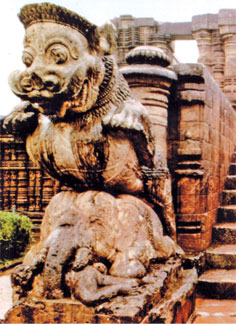Incredible rock-cut monuments of Deccan
by Velamuri PURNIMA
In the Mauryan era during the reign of Emperor Asoka, there arose a
movement in the Indian subcontinent which resulted in a series of
temples and other religious structures being excavated into rock which
have survived the vicissitudes of time.
The northern half of the Indian Peninsula which comprises the Deccan
and the Andhra - Karnataka areas, that are roughly those parts that came
under Mauryan Empire imbibed more from the penetrating art and culture
especially the rock-cut architectural form. The most outstanding feature
of the rock-cut monument art has been from the Buddhist times the
dominance of sculpture over architecture, known as
sculptural-architecture.
 |
|
Lion figure of Kalinga |
Ajanta and Ellora in Western India are good examples of this trend in
sculpture and architecture.
This was facilitated by the softness of the stone material found in
the Deccan plateau.
Ajanta
The story of Ajanta is fascinating. Sometime in the second century BC
the rugged cliff, carved out by a river was chosen to be the site of a
great Buddhist establishment.
There are 31 caves in all, and it is believed that they were carved
in the 2nd century BC as a retreat for Bhikkhus during the rainy season.
Ajanta is also famous for its beautiful murals.
Ajanta's paintings and sculptures are considered to be masterpieces
of Buddhist religious art.
Some paintings reflect the Theravada tradition of depicting the
Buddha only in symbolic form such as a throne or foot prints, Others
feature colourful murals.
The ancient Buddhist rock-cut caves of Ajanta bequeathed to us a
three-fold artistic heritage. Havell, a leading art historian early in
this century had this to say about them.
Symphony
"Very rarely in the world's history has there come together that true
symphony of the three arts: Painting, sculpture and architectonic design
creating the most perfect architecture which are so beautifully
harmonised at Ajanta".
Ajanta was built over a period of time. In the first phase Bhikkhus
and artisans sculpted out shrines for prayer and monasteries for their
stay.
The next phase began around the fifth century AD with Chaitya halls
and Viharas for Bhikkhus who portrayed in their paintings and sculptures
images of the Buddha, their spiritual teacher and guide. The volcanic
rock of the Deccan plateau, rich in minerals provided the colours for
the paintings. The caves were carved out of the solid face of the
hillside, sculpted with pillars, rooms and images and painted almost
simultaneously.
Sigiriya
Another interesting point to note here is the marked similarity
between the paintings of Ajanta and Sigiriya. The Indian architectural
and painting tradition underwent a evolution at Sigiriya.
Similarly in Deccan there were subtle variations in style and their
evolution over the years.
The story of southern Indian stone architecture begins on the sandy
beaches of Mahabalipuram and from here goes on to reach incredible
heights in the Deccan Plateau at Vijayanagar, which is also known as
Hampi.
Vijayanagar (victory city), the 14th century capital of Vijayanagar
empire lies in the Deccan heartland, in the state of Karnataka.
The ruins of Vijayanagar empire in and around the village of Hampi
are spread over an area of more than 25sq kms.
They are one of the most fascinating historical sites in southern
India.
The monolithic sculptures and monuments along the temples are
attractive because of their excellent workmanship. The architecture
found at Hampi reflects the culture and splendour of the Vijayanagar
empire.
Lord Vishnu
The Vitthala temple, the most splendid monument of Hampi dedicated to
Lord Vishnu is on the southern bank of the Tungabhadra river. The
monument dating back to the 15th century and is known for its extensive
sculptured work, ornate pillars and the carvings that decorate them.
The temple is also famous for its beautifully carved towers and
halls. Some of the pillars in the hall contain figures of women dancers
and drummers and beautiful multi-petalled lotus carvings.
This is one of the most ornate Vijayanagar temples built over a
period of time.
Here tapping certain stone pillars produces harmonics that can only
be described as ethereal and its something that's quite impossible. To
imagine until you hear a tune being tapped out on a stone carving of a
drum.
If one strikes the pillars and puts his ears to the cold stone, he
will hear the seven notes of music "Sa Re Ga Ma Pa Da Ni", the clang of
Kanjira, the tinkle of the flute and the beats of the drum.
The stone chariot in front of the temple is very impressive. Its
stone wheels, each shaped in the form of a lotus, revolve. The artisans
of Vijayanagar empire made one significant change in Hampi. In all the
places throughout their vast empire they adapted the hard stone
tradition instead of the then prevalent softstone construction. Hampi
was no exception.
Amazing Saga
The story of Vijayanagar is the amazing saga of how a tiny hamlet
grew into the sprawling medieval metropolis. Its temples are so fabulous
that Hampi can be called an open air museum of temples. The boulders and
rocks of Deccan plateau are ingrained with history and culture and
Vijayanagar civilisation had raised the craft of sculpture to its
glorious heights.
|


